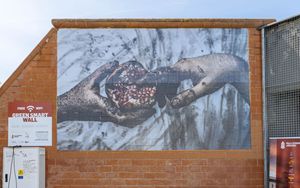(Finance) – For his 10th birthday, Brescia Mobility has chosen to transform the subway cars through the signatures of Demsky and Luca Font cWith their chromatic games and digital aesthetics, the non-profit Yourban2030 hhe has involved companies and brands in urban redevelopment from the north to the south of the peninsula, but also in Amsterdam and New York, Var Group has relaunched the entire Var Digital Art project, the Var Digital Art Award and much more.
To promote and support these new trends that see art as the protagonist in recent months, it is a new patronageor who sees, as in a digital “renaissance”., businesses and private or investee companies promote art themselves, where other forms of support do not arrive. A trend that, in the last year, appears evident:
Therefore, technology meets art, companies and businesses in a new narrative that brings artistic production back into dialogue with the contemporary world by exploiting the new frontiers of artificial intelligence, between videogame aesthetics, Computer Art, Crypto Art, metaverse, NFT, blockchain, AI generative, VR, phygital, but also digital mosaics in bioresin and much more.
An example, all the planning of Yourban2030, guigiven by the entrepreneur Veronica De Angelis, who – in a constant bridge between Italy, Europe and the United States – first brought photocatalytic paints to the old continent and overseas through ecomurales and then bioresin smartwalls, but also the Brescia Metro which – thanks to a network that has involved from BCC Brescia to People of Shibuya, a brand that is also constantly looking for cutting-edge technologies that offer high-level performance for clothing – is completely and literally redesigning its profile, transforming the trains in designer convoys and the spaces of the depot in the Museum of Public Art.
And if the history of the encounter and dialogue between technology and proto-technology and art has its roots in the last century, in Italy, first of all, to intercept the new trends of digital art, in its various forms, was Var Digital Art – a project born within the Var Group, a leading operator in the sector of digital services and solutions for businesses, as a dynamic center for experimentation, study, research and production dedicated to the relationship between Art, Digital and Business. Since 2018 Var Digital Art ha, in fact, launched a reflection and investigation on the advent and diffusion of “new technologies” through the languages of contemporary art, to reflect on their cultural value and their social impact in every field.
Hence the collaboration with IULM AI Labwhose first expression is the forum “The new frontiers of art at the time of AI Generatives”, on 29 June 2023 at 11.00, a moment to share ideas on the subject of art and AI – between education and business and the respective experiences of the IULM AI Lab and Var Digital Art. Opened by Professor Guido Di Fraia, President of IULM AI Lab, pro-rector for innovation and artificial intelligence, and Alessandro Tiezzi, Head of Var Digital Art, Rebecca Pedrazzi (art historian and critic, IULM AI Lab), Davide Sarchioni (Art Director, Var Digital Art ), Martina Rella (art project manager, IULM AI Lab), Jacopo Romagnoli – Head of Innovation – WEB3, Var Group – member of the board, Var Digital Art).
The forum will also be an opportunity to announce a further project resulting from the synergy between IULM AI Lab and Var Digital Art: VDA Award, the biennial award established by Var Digital Art by Var Group which will have its incipit in July 2023. The VDA Award will be aimed at Italian artists whose research constitutes excellence in the field of artistic experimentation linked to the use of digital technologies. Participation in the prize is by invitation formulated by a scientific committee made up of critics, curators, scholars and experts appointed for the occasion. The winner will have the opportunity to participate in some of the LABS of the IULM AI Lab for the year 2024.
More generally, the message is that digital art, born from that “Gen Z” and that “Nerd Generation” raised between codes and algorithms, is finding its place of recognition and election, grafting into the collective imagination a consideration capable of redesigning scenarios: digital art is art, it can tell the world through its own rules capable of permeating everyday life and the new fruition of art itself.
